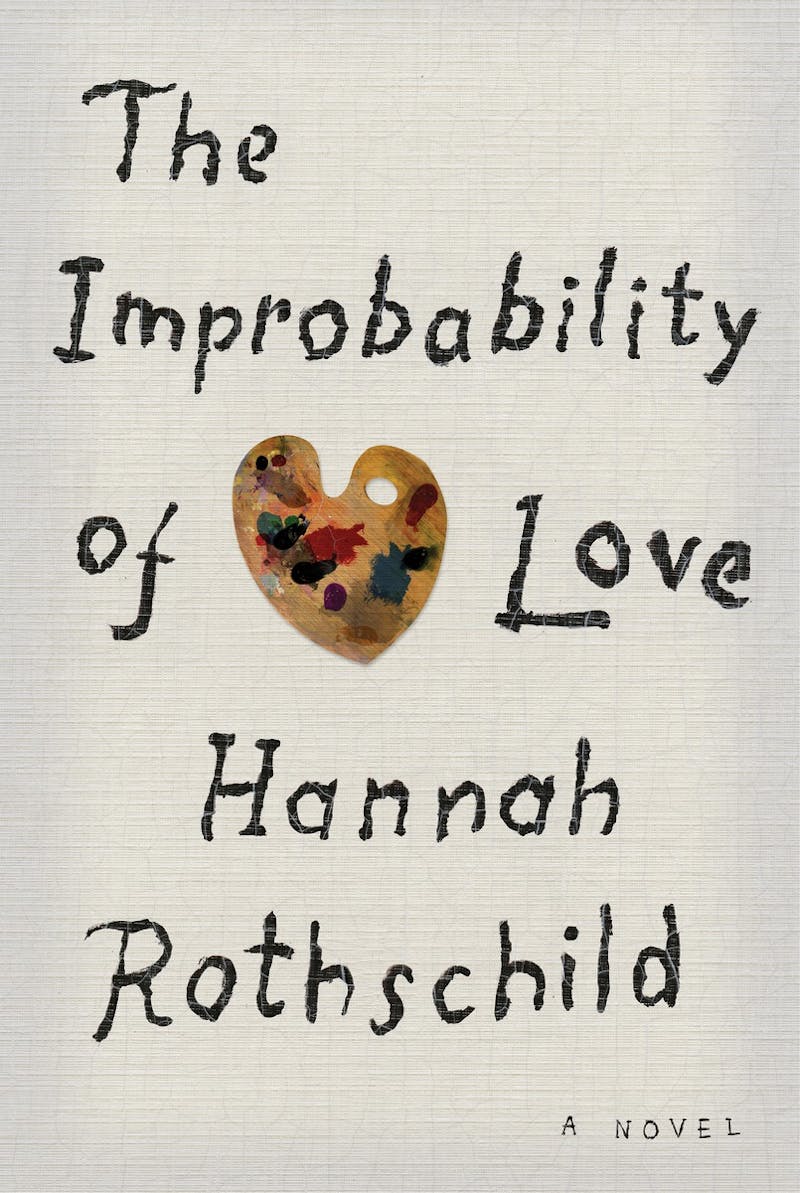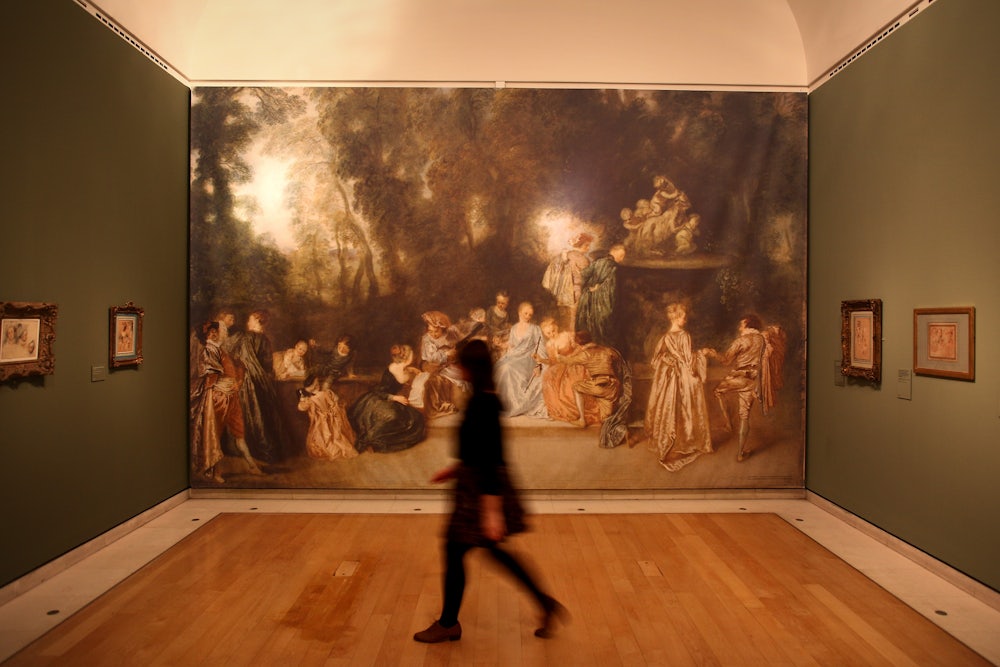If art could talk, how would it sound? This is the question in Hannah Rothschild’s delightful new novel, The Improbability of Love. The art she animates is a long-lost masterpiece by the French painter Antoine Watteau (1684-1721). An alchemist of the rococo, Watteau was a master of the fête galante, that decidedly pre-guillotine genre of French painting that typically features dainty aristocrats milling about in a leafy glade—sometimes dancing, sometimes prancing, but always unaware of the imminent apocalypse. One might expect a painting of this type to sound like Zsa Zsa Gabor, fussing about what to wear to the Revolution. Or maybe a bit like Benjamin Guggenheim as he appeared in Titanic, sipping scotch as the water rushes in.
Au contraire. Rothschild’s imaginary Watteau—titled, naturally, “The Improbability of Love”—is neither. The talking painting (we never know its gender) is saucy, sarcastic, but ultimately soulful, a fount of wisdom delivered with the wizened savoir-faire of Downton Abbey’s Dowager Countess. Occasionally, this particular Watteau throws in a French phrase or two: “My first language is pre-revolutionary French,” it makes sure to remind us. What we get is not so much the ghost of Watteau himself as what it feels like to be a lost masterpiece, the prettiest girl at the party languishing in a London junk shop.
“One has rarely been owned by a person of no class or standing,” the painting, of royal provenance, declares toward the beginning of the novel, lamenting its purchase by Rothschild’s heroine, the would-be chef Annie McDee. When a decent young man gives this Annie his number, the Watteau watches her set the piece of paper aside: “Of course she won’t call him,” it says. “It simply isn’t done.” Then, of course, there are the moments when this painting, a depiction of Watteau’s own unrequited love for a woman much too good for him, speaks in maxims that would make La Rochefoucauld proud. “Love can, for limited periods of time, stave off boredom and hunger but let’s not get carried away,” it sighs. “Death is the only thing humans have to look forward to with any certainty.”
This genre of painting, the fête galante, with Arcadian fantasies by Watteau, François Boucher (1703-1770), and Jean-Honoré Fragonard (1732-1806), is not—and has never been—particularly regarded for its depth. In fact, like the label “Impressionist,” the term “fête galante” was initially derogatory, a dismissal of Watteau by the Académie, whose members initially perceived his paintings as far too frivolous in a time when canvases were meant to be moral, historical, and instructive. A closer look at the fête galante, however, reveals a real complexity and even a darkness. The glades in which the carefree hedonists congregate are almost always clearings in twisted woods; the skies above are palpably still, poised for devastating, cosmic downpours from which there is no escape. In such a world, life is pointless, destruction is imminent, and love is, well, improbable.

It is difficult to say which is Rothschild’s main achievement in this sprawling, plot-laden romp of a novel, her first. On the one hand, through her chatterbox Watteau, she has made a playful but ultimately persuasive argument for the value of the fête galante, still dismissed by art students and critics alike as bon-bon art. You close her book and you immediately want to revisit the museums that preserve this maligned and overlooked moment in art history: the Frick in New York, the Wallace in London, and the Camondo, the Cognacq-Jay, or the Jacquemart-André in Paris. If you do, you will likely find that the real fête galante paintings start to resemble the “Improbability of Love.” They may not speak, but they will appear as the nuanced, challenging and surprising pieces they are.
On the other hand, the novel is a delicious and sometimes devastating satire of what the art world has become in 2015: more fickle than the fashion industry, and arguably more obsessed with money than the financial sector. This is territory Hannah Rothschild knows well. In August 2015, she became Chairman of the Board of London’s National Gallery, an institution that features in her novel, and not without critique. The plot begins when the lovely but lowly Annie, unlucky in life but even unluckier in love, buys the Watteau—one of the world’s great missing masterpieces—on a whim for next to nothing. After she takes a job as the personal chef to Memling and Rebecca Winkelman, the imperious father-daughter team who are also London’s most elite art dealers, Annie brings her Watteau to the attention of “experts” who, quelle surprise, dismiss it out of hand. In time, however, the painting finds itself at the center of an international scandal involving incognito ex-Nazis and heads of state from around the globe.
Ultimately, The Improbability of Love is set in the same city we see in China Miéville’s London’s Overthrow and John Lanchester’s Capital, a global cosmopolis whose imperial shell is awash with cash but devoid of soul. Rothschild gleefully includes virtually all the archetypes of this modern dystopia, one by one. There are the émigré Russian oligarchs filling their Belgravia townhouses with priceless art they treat like dormitory posters, the impoverished English aristocrat forced to work as a St. James’s auctioneer, and, finally, the hardworking Annie, whose honesty takes her nowhere but prison (only for a while).
Early on, it becomes clear that Rothschild uses her vast and colorful cast of characters to say the things she herself cannot say. “We can be serious in Spitalfields, grungy in Golders Green or chic in Chelsea,” says a man-about-town to one of the émigré Russians. “Mind you, the venue changes, the people don’t. Funny how insular cultural life is: same old, same old.” Coming from a custodian of the National Gallery, the grande dame of London’s cultural institutions, that packs more than a little punch.
Another choice example of Rothschild’s refreshing humor comes when this same Russian, called Vlad, visits the Tate Modern to see a Damien Hirst show, presumably the blockbuster retrospective that ran there in real-life in 2012. “Walking through the rooms he saw the artist try out the same ideas in different forms: life, death and spots over and over again,” Rothschild writes. “Vlad tried to be moved or interested in these themes, tried hard to feel and understand what Hirst was telling him. Nothing happened.”
Hirst, the prince of the “Young British Artists,” has soared to staggering heights with his bad-boy (but commoditized) aesthetic, even opening a gallery of his own this past October in—mais bien sûr—trendy Lambeth: the Shoreditch of the YBA past has presumably become too establishmentarian for the most anti-establishment member of the new establishment. Although there is much to say about Hirst’s work—cows and calves floating in formaldehyde, gem-encrusted skulls—it is, in a sense, a material translation of London today: shock, awe, and, above all, price. Enough of that spectacle, and one pines for the world of Watteau: at least then, the decadence was delicious.
Life, The Improbability of Love suggests, has always been something of a fête galante. So pop the cork and head to the glade. Because whether you chose the formaldehyde cows or the antics of the ancien régime, the storms are coming anyway.
